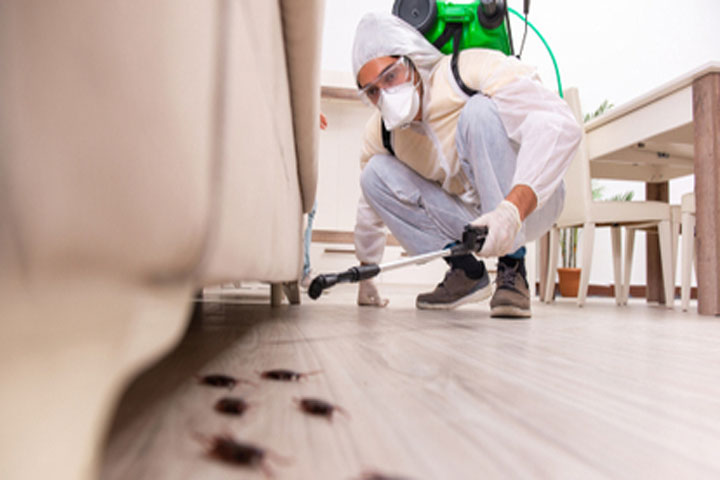Professional Parasite Control Techniques for Long-Term Outcomes
In the world of bug control, attaining continual effectiveness and long-lasting results requires a meticulous technique that goes beyond plain extermination. Expert bug control strategies envelop a detailed method that starts with a detailed assessment and evaluation, adhered to by accurate bug identification to comprehend their habits patterns. The application of Integrated Parasite Monitoring (IPM) principles, combined with eco-conscious therapies, forms the foundation of lasting insect elimination. The real examination lies in the continuous monitoring and upkeep of the dealt with areas, guaranteeing a pest-free atmosphere for the direct future. By diving right into the complexities of these methods, a much deeper understanding of specialist pest control techniques for withstanding results arises.
Inspection and Evaluation
Upon getting in a home for pest control services, the initial action is a comprehensive assessment and analysis to identify the degree of the infestation and identify one of the most reliable therapy strategy. Professional parasite control professionals are educated to carefully analyze the facilities, seeking signs of insect task such as droppings, nibble marks, nests, or any type of structural damages. They will also analyze the problems that may be bring in bugs, such as food sources, water leakages, or entry factors.

Insect Recognition and Actions

Furthermore, understanding the actions of the determined pest is crucial to implementing reliable control steps. Understanding where parasites nest, what they feed on, and their task patterns can aid pest control experts design approaches to eradicate them successfully.
Integrated Pest Administration (IPM)
Integrated Parasite Monitoring (IPM) methods combine several strategies to control and stop pest invasions in a lasting and environmentally friendly fashion. pest control near me. By integrating techniques such as organic control, environment manipulation, adjustment of social techniques, and using resistant ranges, IPM intends to reduce the usage of chemical pesticides
Among the key concepts of IPM is the focus on avoidance. This proactive strategy involves surveillance insect populaces frequently to detect any type of potential problems prior to they escalate. By determining parasite issues early on, pest control procedures can be applied click for more info swiftly and efficiently.
In addition, IPM promotes making use of non-toxic insect control approaches whenever possible. This can consist of using natural predators of the parasites, introducing helpful bugs, or making use of pheromones to disrupt breeding patterns. By lowering dependence on chemical pesticides, IPM not only shields the environment yet likewise assists maintain a balance in the ecosystem.
Environmentally-Friendly Therapies
Implementing eco-conscious techniques in insect control procedures can effectively resolve problems while prioritizing ecological sustainability. Environmentally-friendly treatments focus on minimizing the effect of insect control approaches on communities, non-target organisms, and human advanced pest control health.
One more key facet of environmentally-friendly treatments is using natural and naturally degradable items that break down swiftly without leaving hazardous residues in the environment. Botanical insecticides acquired from plants like chrysanthemums or neem provide reliable pest control while positioning marginal risk to non-target types. Utilizing approaches like heat treatments or scent catches can target particular bugs with accuracy, minimizing the overall ecological influence of insect control techniques.
Ongoing Tracking and Upkeep
Regular inspections by experienced specialists are needed to identify any kind of indications of insect activity, assess the performance of previous treatments, and make adjustments to the parasite control strategy as needed. By checking insect populations over time, bug control professionals can track trends, prepare for prospective issues, and carry out precautionary steps to minimize the threat of future invasions.
In addition to surveillance, maintenance methods are essential for long-term bug control success. This includes carrying out proper hygiene steps to remove potential food and water resources for Go Here parasites, securing off entry indicate prevent bugs from going into the properties, and resolving any type of architectural problems that can facilitate pest invasions (bed bug dog). By incorporating ongoing tracking and upkeep into an integrated parasite monitoring technique, businesses can make sure a pest-free atmosphere and guard their residential property against pricey damage and wellness threats
Final Thought
Finally, using expert pest control techniques such as comprehensive inspection and analysis, exact bug identification and understanding of their behavior, incorporated insect management strategies, environmentally-friendly therapies, and continuous monitoring and upkeep are necessary for accomplishing long-term outcomes in bug control. By executing these methods, people can successfully manage pest infestations and keep a pest-free atmosphere in a sustainable fashion.